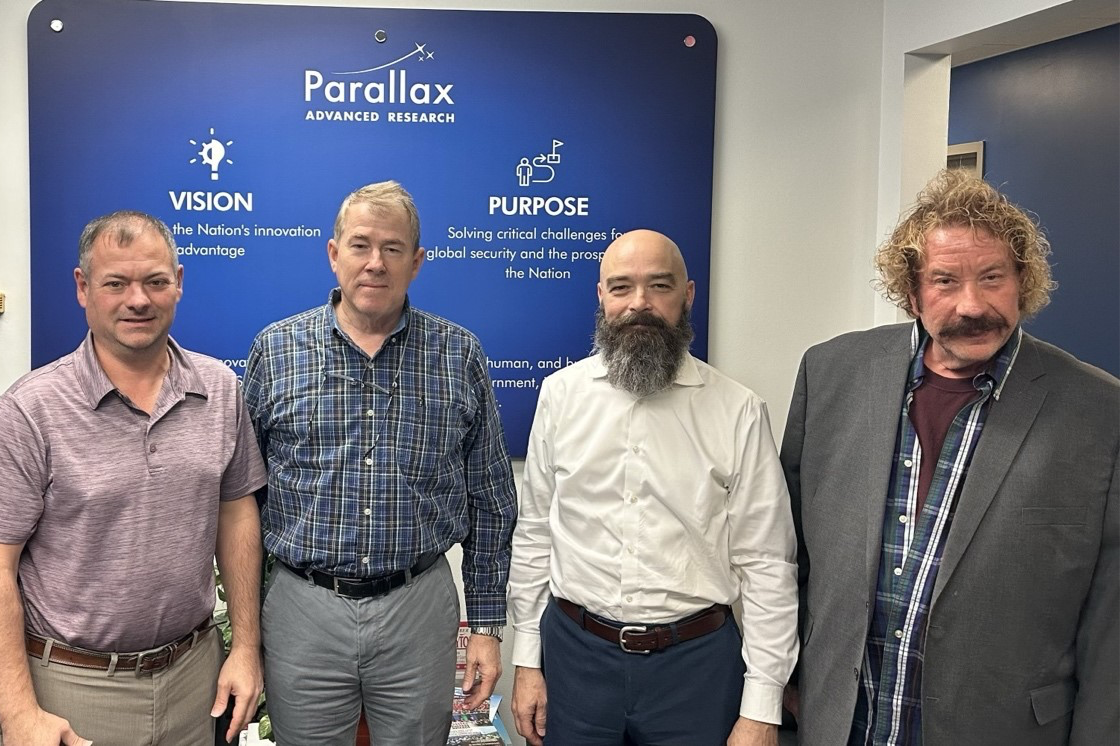- Parallax Advanced Research and Southwest Research Institute (SwRI) EW Team; left to right: Mr. Justin S. Tieman, Principal Engineer, SwRI; Mr. Keith G. Dufford, Senior Program Manager, SwRI; Mr. David A. Brown, Institute Engineer; and Director AI Hardware Research and Neuromorphic Center of Excellence, Parallax; Dr. Steven D. HarbourParallax Advanced Research and Southwest Research Institute (SwRI) EW Team; left to right: Mr. Justin S. Tieman, Principal Engineer, SwRI; Mr. Keith G. Dufford, Senior Program Manager, SwRI; Mr. David A. Brown, Institute Engineer; and Director AI Hardware Research and Neuromorphic Center of Excellence, Parallax; Dr. Steven D. Harbour
The convergence of artificial intelligence and defense technologies is poised to redefine the future of electronic warfare (EW). This shift, driven by third-generation AI techniques like spiking neural networks (SNN) and neuromorphic research, represents a critical step forward in equipping the U.S. military with innovative and adaptable solutions. We spoke with Dr. Steven Harbour, Parallax Advanced Research director of AI Hardware Research and a leading expert in neuromorphic research, to explore how his team is advancing AI capabilities and addressing emerging challenges in defense.

Exploring AI’s Next Frontier
Traditional AI excels in tasks it has been trained on, demonstrating precision in recognizing familiar patterns and processing expected queries. However, Harbour highlights a significant limitation: AI's brittleness when confronted with the unexpected.
“AI today can fail catastrophically when faced with situations it hasn’t seen before,” he said.
Humans, on the other hand, adapt to the unknown through cognitive problem-solving, a capability that AI systems must emulate to address future challenges effectively.
SNNs, inspired by the human brain’s functionality, offer a promising solution. Unlike traditional feedforward neural networks rooted in inferential statistics, SNNs excel in rapid decision-making under uncertainty, making them particularly suited for dynamic environments like electronic warfare.
Harbour says, “The direction we’re moving in is solving the unfamiliar and addressing the unknown threats quickly and effectively.”
Scaling Neuromorphic Systems
Parallax is at the forefront of advancing third-generation AI algorithms, partnering with Intel and Brainchip to develop scalable neuromorphic hardware.
Harbour says, “Both Intel’s Loihi and Brainchip’s hardware appears plausibly scalable for platforms like fighter aircraft or drones.”
In terms of deployment, neuromorphic processors can be integrated into existing electronic countermeasure (ECM) pods, widely used in both Air Force and Navy operations. These pods, which are part of strike packages including crewed and uncrewed aircraft, offer a clear pathway for fielding these advanced systems across the Department of Defense (DoD).
As Harbour said, “The ultimate goal is scalability across air, sea, land, and space domains, ensuring these systems operate effectively on the front lines.”
The Role of Partnerships in Shaping AI Research
Collaboration plays a pivotal role in advancing neuromorphic research. Parallax, headquartered in Dayton, Ohio, benefits from proximity to leading institutions like the University of Dayton and the University of Cincinnati. Harbour’s connections with researchers like Professors Dr. Tarek Taha, Dr. Chris Yakopcic, and Dr. Vijayan K. Asari University of Dayton and Dr. Kelly Cohen an Endowed Chair and Lab Director at the University of Cincinnati have led to innovative projects, including combining “fuzzy” logic with Neuromorphic SNNs to enhance AI decision-making.
Parallax’s independent research efforts are further bolstered by partnerships with institutions like Intel and Brainchip, ensuring access to cutting-edge neuromorphic technologies. These collaborations not only drive technological innovation but also foster a thriving research ecosystem essential for addressing the unique challenges of EW.
Evolving Applications in Defense Technologies
Over the next few years, an AFLCMC initiative will focus on developing and deploying third-generation AI algorithms on neuromorphic platforms. According to Harbour, the initiative aims to create “fieldable systems that can operate effectively in air, sea, land, and space environments.” This vision extends to supporting broader DoD efforts, including AFRL’s test facilities and ongoing collaboration with Southwest Research Institute.
The adaptability of these systems will be critical for countering emerging threats. Harbour envisions a future where AI-powered EW solutions can address the unknown, enhancing situation awareness and enabling rapid response in high-stakes scenarios.
“The future challenge is solving the unfamiliar—understanding and reacting to unknown electronic signatures or techniques deployed by adversaries,” he said.
AI and the Future of EW
As neuromorphic research progresses, its impact on EW solutions for the U.S. military is undeniable. From enhancing strike packages to integrating AI into naval, land, and space operations, the potential applications are vast. Harbour emphasizes the importance of continued innovation and collaboration:
“Parallax is uniquely positioned to lead this charge, combining our research expertise with strategic partnerships to drive the next generation of EW solutions.”
Through its pioneering work in AI and defense technologies, Parallax is shaping a future where adaptability and innovation are the cornerstones of national security. By bridging the gap between academic research and practical deployment, the team is ensuring that the U.S. military remains at the cutting edge of electronic warfare capabilities.
###
About Parallax Advanced Research & The Ohio Aerospace Institute (OAI)
Parallax is an advanced research institute that tackles global challenges through strategic partnerships with government, industry, and academia. It accelerates innovation, addresses critical global issues, and develops groundbreaking ideas with its partners. With offices in Ohio and Virginia, Parallax aims to deliver new solutions and speed them to market. In 2023, Parallax and OAI formed a collaborative affiliation to drive innovation and technological advancements in Ohio and for the nation. OAI plays a pivotal role in advancing the aerospace industry in Ohio and the nation by fostering collaborations between universities, aerospace industries, and government organizations, and managing aerospace research, education, and workforce development projects.
